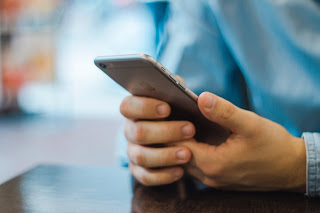 |
| Image Credit: Pexels |
Author: MohammedMoiz Qureshi, MD
AAEM/RSA President 2018-2019
Originally Published: November/December Common Sense
List your most intimate relationship. Most of us will list a spouse, parent, sibling, relative, or friend. Most of us however will also forget our most intimate — our beloved phones.
They keep us company when we eat, they’re the last things we see before sleep, and they’re the first things we reach for when we’re stressed. And according to some data, we check them, on average, over 60 times a day. For us in medicine, they serve as a great resource. They allow us to look up new cancer drugs we’ve never heard of, remind ourselves of rates when we forget how to start tube feeds, and of course they serve as the clock we check counting the hours till relief checks in.
But does our dependence on phones go too far? From what we’ve observed in modern day society most of us agree yes, but what about in medicine? Are we allowing ourselves to lower our previous demands to memorize certain algorithms and pathways that we learned from repetition and become dependent on our technology? Most importantly are we letting it affect patient care?
The cost benefit ratio can be argued endlessly. An article from 2013 concluded that “findings suggest there is very little research evidence that supports the use of mobile devices in the ED and more research is needed to better understand and optimize their use.” So anecdotal sup-port is currently all we really have. Holding state of the art technology with access to groundbreaking research in the palm of your hands for instantaneous access is invaluable; but how does it compare when there are comical memes pinging your notifications as you frantically search the mg/kilo dose of succinylcholine on a crashing pediatric patient? Many argue a total ban of phones in hospital settings, while others vehemently advocate its benefits like FOAMed and HippoEM. So where does the balance lie?
As a millennial myself, I’d say that a ban will almost always fail. I’ll refer to our ancestors with the glaring success of alcohol prohibition as evidence. But I do think that there are ways we can make phone use more professional for our patients and ourselves. Finances and budgets aside, it would be ideal to have a separate work phone and personal phone. But seeing how the new iPhone Xs Max is well over a thousand dollars that may not be the most feasible idea. If we accept that having immediate access to resources as a definite benefit but having the easily accessible distraction of social media a definite negative, perhaps Apple and Android can create an alternate user operating system. Akin to the “Do Not Disturb” mode people use to sleep, or the new “Distraction-less Driving” feature on the iPhone, perhaps there can be a professional mode option that hides apps like Facebook and Instagram, but still allows functionality for apps like Pepid and Pedistat. Having this mode would allow us to toggle back and forth and hopefully prevent that awkward moment when you forgot to silence your phone and your Macarena ring tone goes o” in a patient room.
So what do we do in the meantime while I pitch what I hope is a multi-million dollar idea to Apple? I would advocate that we ensure we are spending as much time as we can with our patients face to face and explaining our cell phone use when we do get those side glances and raised eyebrows. Often it may also be helpful to show them what we see on our screens in terms of drug databases and research articles. We can also go further as part of our patient education, and provide insight into helpful apps that we use like MDCalc to incorporate shared decision making. All in all, it falls back on that ever so important concept of communication that was harped on in our medical education. By ensuring we are explaining our cell phone use and how they are so helpful to us in caring for patients, creates a more positive atmosphere and helps foster the sense of trust and respect that we strive to achieve.
